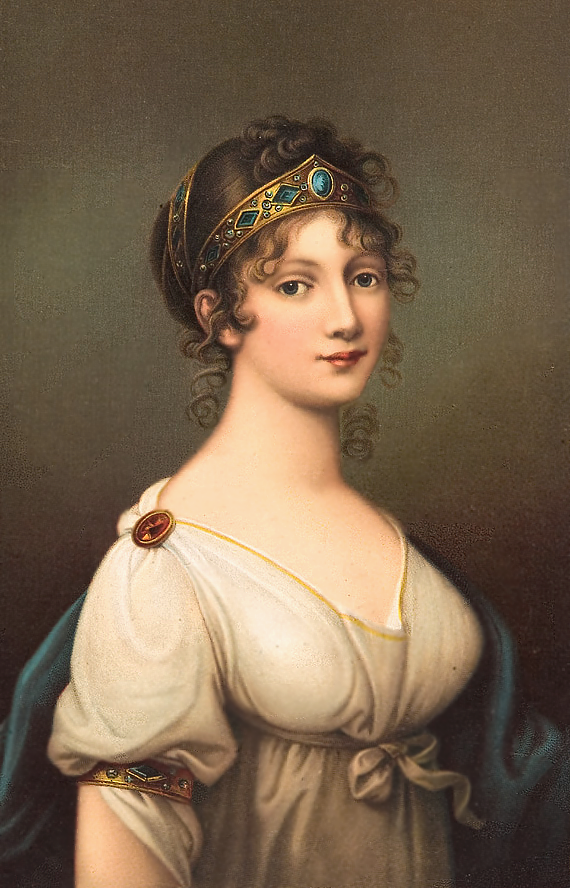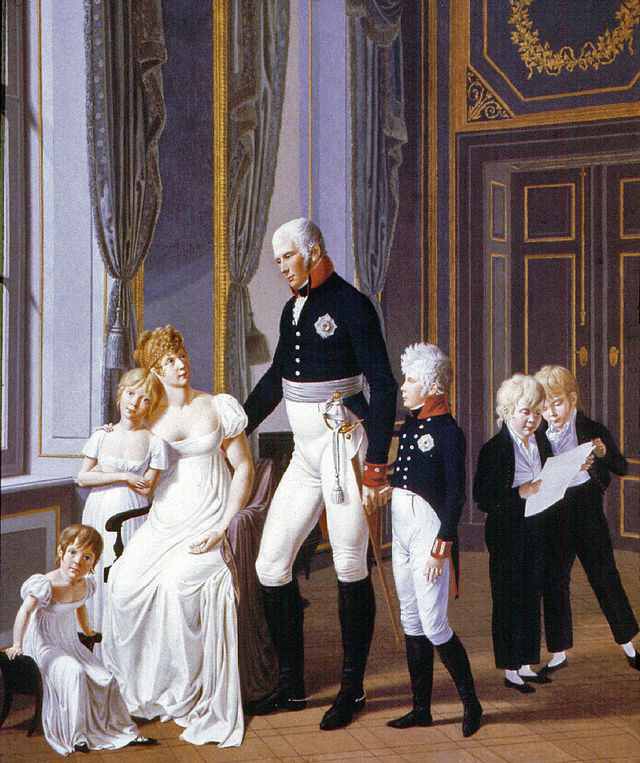Duchess Louise of Mecklenburg-Strelitz was married to King Frederick William III of Prussia, making her the Queen Consort, from 1797-1810. In 1807, Louise met with Napoleon I, the French Emperor, to plead him to leave Prussia out of the war, though was ultimately unsuccessful. While her subjects already loved her, meeting with Napoleon only made her people love her even more and she was a very popular queen, though Louise died young when she was thirty-four.
On March 10, 1776, Duchess Luise Auguste Wilhelmine Amalie of Mecklenburg-Strelitz (in English, Luise is spelled Louise) in her family’s one storey villa just outside of Hanover. Her father was Duke Charles of Mecklenburg and her mother Landgravine Friederike of Hesse-Darmstadt. Louise was their fourth daughter and sixth child out of ten. Louise was not born in in a court because her father was not yet the Mecklenburg-Strelitz. He succeeded his brother in 1794. When Charles was made a governor general, the family moved to Leineschloss.During the summer, Louise and her family usually stayed in Herrenhausen.
Growing up, Louise and her younger sister Frederica and their only brother, George. Their mother’s friend and their governess, Fraulein von Wolzogen, looked after the children. Louise was six years old when her mother died in childbirth, and Louise was devastated. If she saw other children without mothers, she would give them some of her pocket change because they were like her in the fact they also had no mother. The family then moved permanently to Herrenhausen. Two years later, Charles remarried Charlotte, his first wife’s younger sister, and they had a son named Charles. Louise became close with her new stepmother, but she soon died and Charles went to Darmstadt, putting his children into the care of his mother-in-law.
Soon, Louise and her siblings were living with their grandmother, who wanted them to be raised as simply as possible. They made their own clothes. A governess from Switzerland was appointed to teach them the common royal and aristocratic language of French. Louise began to abandon German, her native tongue, as she became fluent in French. A Lutheran clergyman taught the children religion. Often times, Louise joined her governess in going around to visit those who were poor and in needy. The childrens’ governess taught them to give out as much in need to those as possible. Her grandmother often got angry with Louise for donating a bit too much. From ten until she got married at seventeen, Louise spent almost all of her time with either her governess or her grandmother. She loved history and poetry especially.
Louise’s grandmother took her two youngest daughters to Frankfurt with her in 1793. There, Louise and her sister paid their respects to their grandmother’s nephew, King Frederick William II. By this time, Louise had grown up to become a very beautiful young woman, and her uncle, the Duke of Mecklenburg, was hoping he could strengthen the relationship between his house and Prussia.The Duke planned for the seventeen year old to meet Crown Prince Frederick William. Louise charmed the very serious and religious twenty-three year old crown prince, and he immediately wanted to marry her. Meanwhile, Frederica caught the crown prince’s younger brother’s, Prince Louis Charles, eye. Soon, they were planning a double betrothal that was celebrated the following month in Darmstadt on April 24, 1793. Louise married Frederick on December 24, 1793, and two days later, Frederica married Louis.
Before the marriage, Louise arrived in the capital of Prussia, Berlin, and was a sensation. She even broke protocol to pick up and kiss a child. The people loved her from the very start.
While the newly married couple was gifted Charlottenburg Palace by King Frederick William II, they usually stayed near Potsdam at Paretz Palace. They prefered Paretz because it was so far from court life, and there Louise stayed busy managing household affairs. Louise and Frederick were very happy together, and Louise supported him always. The king even called Louise “the princess of princesses” and everyone seemed to love her. The following year on October 1, 1794, Louise gave birth to their first child, but sadly, it was a stillbirth. They had nine more children: Crown Prince Frederick William (1795), Prince William (1797), Princess Charlotte (1798), Princess Frederica (1799), Prince Charles (1801), Princess Alexandrine (1803), Prince Ferdinand (1804), Princess Louise (1808), and Prince Albert (1809). However, both Princess Frederica and Prince Ferdinand died as children.
Throughout her life, Louise continued to give to charity. There was one time where she was at a harvest festival and she bought many presents to give to the children in attendance. After she married Frederick, the king asked her on her birthday what she wished for a gift. Louise asked for money to give to the people in Berlin, and the king gave her a large amount of money to do so.
King Frederick William II died and King Frederick William III succeeded him on November 16, 1797. “I am now queen, and what rejoices me the most is the hope that now I need no longer count my benefactions so carefully,” the new queen consort wrote to her grandmother. They left Paretz and spent most of their time under the constraints of the court. Soon, the couple embarked on a tour through the eastern Prussian provinces. There were two reasons for this, one, the king wanted to get to know his new subjects, and also to introduce everyone to their new queen. This was the first time in the history of the country that the queen was celebrated as a public personality. Louise was much more prominent as queen than previous queens. Along with that, Louise became a fashion icon, and one one such instance, she wore a neckerchief as not to get ill, and it became a trend.
Soon, Louise was a very powerful figure in Prussia. She commanded respect and affection from everyone. Louise always made sure she was informed on politics, and the king often times consulted her when it came to state matters. Frederick hated war and wanted to remain neutral, so struggled on what to do during the War of the Second Coalition, which lasted from 1798-1802. He was pressured to pick a side. Louise warned that if they sided with Austria, Great Britain, and Russia, that may cause to them having to depend on Russia. Prussia was not a strong country, and was quite weak. But because of aggression from France and Napoleon, Frederick eventually had to choose a side. Instead of joining the coalition powers, he decided to ally with Napoleon.
The queen along with the king’s younger brother, Prince Louis Ferdinand, both supported war against France. On the other hand, Baron vom Stein and Karl August von Hardenberg were the leaders of those were did not agree with neutrality, but wished for reform. Hardenberg put the king’s temperament into consideration and ended up appealing to Louise for the reform they desired.
Military leaders in Prussia were confident that they could beat Napoleon’s troops, even though the last war they fought was many years before in 1795. Louise and other members of the royal family pressured the king to break off the alliance with France and instead enter the war against Napoleon. Soon, Prussian troops were mobilizing and the Battle of Jena-Auerstedt in October 1806, but the battle was a disaster for them. Louise and Frederick had been there to accompany the troops into battle, but fled from the French. Apparently, the queen had been dressed as an Amazon.
It wasn’t long before Berlin was occupied by Napoleon, and Louise, Frederick, and the rest of their family fled to Memel, which was in the east. At the time, Louise was very ill. The royal couple were forced to share the same sleeping arrangements in barns on the journey, and there was also no clean water or food.
In 1807, Napoleon demanded they come to peace terms. The terms of their peace was later called the Treaties of Tilsit. While they were negotiating, Napoleon agreed that half of Prussia would be left intact. Frederick sent for the pregnant at the time Louise to beg for Napoleon to settle with Prussia. He believed that perhaps Louise might make Napoleon more relaxed, and she reluctantly agreed to meet with the emperor. Though the only reason she did was because she was hopeful she could save her country. Previously, Napoleon had questioned her marital fidelity in an attempt to ruin her reputation. When the queen met with him, she used her charm and beauty to try and flatter him. In the end, he failed to damage her reputation, and in fact, his efforts only made the Prussian queen more beloved in her country because of her efforts to save Russia.
Louise was particularly devastated about the results of the French occupying Prussia. This was mainly due to all the insults made on her. But she knew that the Prussians relied on her for moral strength, so she stayed optimistic and was also trying to prepare her oldest son for what would happen when he became king. After the war, Louise supported many reform efforts that were carried out by Stein and Hardenberg along with others trying to reorganize the army.
The royal family was still unable to return to Berlin. They normally spent their summers near Königsberg instead. Louise felt that the hardships she and her children went through would be good for them so they did not always believe they were entitled to luxury. She and Frederick were invited to Russia in 1808 by Tsar Alexander I, and not long after, their youngest child, Princess Louise, was born. For most of the year, Louise was quite ill. Three years passed from the time they left Berlin until they were finally able to return. Louise was accompanied back with her children Charlotte, Alexandrine, and Charles. Her father greeted her in Berlin at Charlottenburg Palace as well. But, the palace had been ransacked and almost all of the paintings, statues, manuscripts, and antiquities had been taken by Napoleon.
Louise was visiting her father in Strelitz and was ill at the time when she died on July 19, 1810 in the arm of her husband. It is unknown what she was ill with. Many believed that she had died young at the age of thirty-four due to all the added stress of the French occupation. Napoleon apparently told Frederick that he had “lost his best minister”. Louise was buried at Charlottenburg Palace. Frederick remarried in 1824 to his mistress from a few years before, Auguste von Harrach, and died in 1840, buried next to his first wife.



